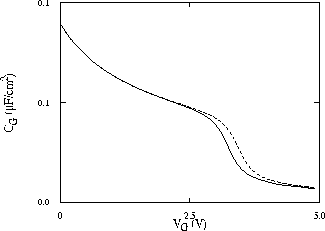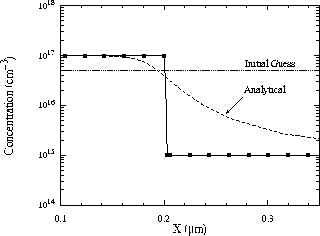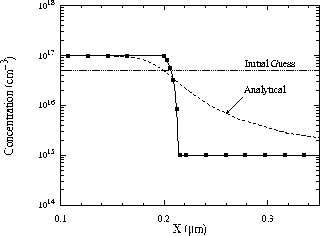

where  =
=  is the extrinsic
Debye length at
is the extrinsic
Debye length at  (
( );
);  is the Bolzmann
constant,
is the Bolzmann
constant,  is the absolute temperature,
is the absolute temperature,  is the dielectric
permittivity of silicon, and
is the dielectric
permittivity of silicon, and  is the doping concentration.
is the doping concentration.





Since no analytical approximations are required in the numerical solution of Poisson's equation, the method has a better resolution than analytically based profile extraction methods [109][49]. Indeed some of the classical Debye length limitations associated with C-V extraction techniques stem directly from these approximation and are not inherent to C-V profiling per se. To validate the previous statement, the numerical experiments of [49] were repeated. First the C-V characteristics of a MOS capacitor was simulated using two profiles:


where  =
=  is the extrinsic
Debye length at
is the extrinsic
Debye length at  (
( );
);  is the Bolzmann
constant,
is the Bolzmann
constant,  is the absolute temperature,
is the absolute temperature,  is the dielectric
permittivity of silicon, and
is the dielectric
permittivity of silicon, and  is the doping concentration.
is the doping concentration.
In Fig. 4.18, the two CV characteristics simulated using the profiles A and B are plotted. As seen, there is clearly a difference between the two characteristics that could be used to reconstruct the original profiles.

Figure 4.18: Comparison of CV characteristics of profiles A (solid)
and B (dashed).
The two step profiles were parameterized using the length of the transition
region and the two levels of doping ( ,
,  ,
,  ). Using
nonlinear least squares parameters extraction, the values of the step profile
parameters were then extracted from the capacitance data.
). Using
nonlinear least squares parameters extraction, the values of the step profile
parameters were then extracted from the capacitance data.
In Fig. 4.19 and Fig. 4.20, profiles A and B are shown with the analytically extracted profiles using (4.6) and (4.7), as well as the profiles extracted using the inverse modeling method from the same data. As originally reported in [49], both analytically extracted profiles are a poor approximation to the original step profiles and are indistinguishable. On the other hand, it is clear that the original profiles can be reconstructed using the inverse method.

Figure 4.19: Comparison of Profile A (symbols) and the extracted profiles using
the analytical approach (dashed) and the inverse modeling
method (solid).

Figure 4.20:
Comparison of Profile B (symbols) and the extracted profiles using
the analytical approach (dashed) and the inverse modeling
method (solid).




